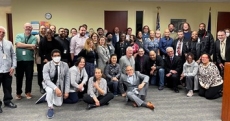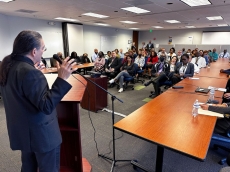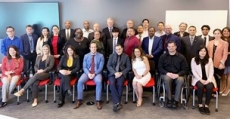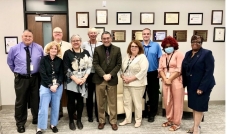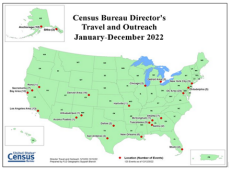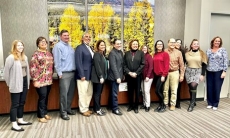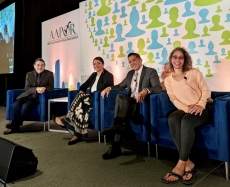In the Year 2022…
In the Year 2022…
I was sworn in by Secretary Raimondo as the U.S. Census Bureau’s 26th director at the Department of Commerce Hoover Building on the afternoon of January 5, 2022. It was an honor of a lifetime and incredibly humbling.
And I was happy just to be there. My wife and I had arrived in the DC metro area only a day earlier, after a treacherous three-day road trip from Austin, Texas. The travel should have taken two days, but a heavy snowstorm stalled us outside of Nashville. For a while we didn’t know if we’d make it to the ceremony. The only belongings we carried with us were whatever fit in the back of our compact SUV. Besides a few clothes, they included such items as an air bed, some camping chairs, an outdoor collapsible picnic table, TV trays, and a plant. We settled into an empty condo on January 4, and thus began our auspicious new adventure to serve our country.
Well, 2022 has been quite a year. All I wanted to do was to help the Census Bureau – its staff, its leaders, and our country. So, let me tell you a little bit about my experience this year.
Just after I started, a friend of mine who is a Census Bureau data user and stakeholder congratulated me and then intimated – almost in a whisper – that directing the Census Bureau was like “steering an aircraft carrier with a canoe paddle.” Indeed, our beloved Census Bureau is a large, glorious organization of excellence. The momentum to stay on a set course can be considerable, although the pandemic proved to everyone that adaptations can be made nimbly and successfully when necessity requires. But looking back, perhaps this friend was correct in his metaphor . . . that is, if one intends to lead alone.
As a leader, that’s just not my style. I’ve always seen leadership as that of being the nurturer, the enabler that helps staff realize their true potential, becoming the best they can be. I mentioned that at my Senate hearing. I repeat it here because I believe it strongly and I lead by example. I seek to lead with compassion, exemplifying how to use our core values to make decisions that help achieve our mission. And our mission is simply irresistible: providing quality data on the nation’s people and economy. For us data geeks, it doesn’t get any better than that. It puts a smile on my face every day.
I have embarked on this leadership journey with a secret weapon: the knowledge and lived experience garnered over a 40-year career, often being the sole person of color in a room full of decision-makers. I learned the value of insights that emerge from diverse voices/perspectives that includes community engagement from the data users, from stakeholders, and from partners and others. Enabling staff includes the opportunity to learn and see firsthand the value of inclusion.
So, my inaugural year has focused on inspiring, encouraging, nudging and offering alternative perspectives. It’s also featured recognition and appreciation of the excellence that has always been the embodiment of our Census Bureau staff. I have also spent much time engaging with stakeholders, partners and local communities; tribes in a nation-to-nation context; and with my colleagues in the federal statistical system. I have also reached out to Congress and the rest of the federal government. And through these engagements, I have been honest, direct and respectful. That’s how our core values of scientific integrity, transparency, objectivity and independence can shine through.
Now let’s review some of this year’s highlights from the Census Bureau and some of my activities in 2022.
Throughout 2022, the Census Bureau continued its excellent operations. We released data related to the 2020 Census, the American Community Survey, the Household Pulse and Small Business Pulse surveys, and many more. We’ve created new tools and data products. We participated in the release of historical data from the 1950 Census, along with the National Archives and Records Administration. We’ve been conducting the employment and finance component of the 2022 Census of Governments and gearing up for the 2022 Economic Census. And, of course, we’ve been preparing for the 2030 Census.
As I’ve said many times this year – including here in my blog – the Census Bureau is committed to producing data that reflects an accurate portrait of America. To accomplish that, over the past year I have championed data equity, incorporating diversity and inclusion in our workplace, and engaging with the full diversity of our stakeholders.
An important – and heartwarming – aspect of these priorities has been meeting with many Census Bureau employees face-to-face to learn more about their work and to hear their feedback. I met staff both individually and in groups at our headquarters in Suitland, Md., as well as all at six regional offices and the National Processing Center.
RO/NPC visit photos
Meeting with so many staff members in different roles was fascinating, inspiring and illuminating. As a statistical agency, we’re facing new and complex data user needs, data collection challenges, and the demand to do more with less. Census Bureau employees are our on-the-ground experts who work diligently to better serve the American public.
Two themes were universal and noteworthy in my interactions with career staff: dedication to mission, and pride in serving our nation as a civil servant. Seeing the focus of staff on creating quality data on our nation’s economy and people was extremely important for me.
Why? Well, here are some Census Bureau data uses – they represent just the tip of the iceberg. We are using our data to help the Department of Commerce facilitate the implementation of the CHIPS and Science Act, the Infrastructure Investment and Jobs Act, and the American Rescue Plan Act. More generally, our data are used to develop our economy. For instance, private corporations use our data to make billion-dollar investment decisions on manufacturing plants and trade deals. Local governments use our data for economic development, public health planning, and emergency planning. Congress and courts use our data for planning, monitoring and regulation. Scholars use our data to create new knowledge about who we are as a people, an economy, and as a nation. Policy researchers use our data to improve our society, identify inequities, and help the underserved.
Speaking of inequities, our Data for Equity webpage contains all Census Bureau data equity products that can be used by policymakers and the public to advance equity. Some of our data equity services include demographic data, data tools, public assistance program metrics, diversity measurement, and data education.
I hope you’ll check out these resources including new ones that we rolled out this year, like the web-based data tools in support of the Digital Equity Act that we produced in partnership with the National Telecommunications and Information Administration. Our Mapping Digital Equity in Every State and the Digital Equity Act Population Viewer tools give the public needs accurate data about what our nation looks like, including its underserved communities.
Next, let’s turn to my external outreach activities in 2022. A priority of mine was to seek out and listen to diverse voices across our nation. To that end, I visited 17 states and the District of Columbia to meet with advocacy organizations; state, local and tribal government officials; philanthropic groups; community-based organizations; businesses; scholars; and more.
My conversations with these diverse communities were wide-ranging. They included tribal consultations, keynote speeches at conferences, meetings with community leaders and government officials, speaking to college students at historically Black and Hispanic colleges and universities (HBCUs and HSIs) as well as flagship state universities, to name a few. We talked about topics like data protection and privacy, 2020 Census data products and data quality, race and ethnicity statistics, and planning for the next census in 2030.
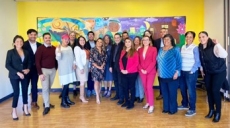
Meeting with the Unity Council in Oakland, California
I was interviewed by media as well as students of all ages, including a 10 year old for our corporate partner Wonderama; a public radio in Sitka, Alaska; and the local newspaper in Selma, Alabama. I even helped to recognize the official center of the U.S. population in Hartville, Missouri. Stakeholder feedback is critical to understanding the needs of our data users and to our decision making. I appreciate these groups offering us their time and perspectives, and I look forward to connecting with and hearing from even more communities in the coming year.
All in all, 2022 has been transformational for me as a leader. I am embracing the role of being a true public servant leading the largest federal statistical agency in the United States. I am a proud, unapologetic “work in progress.” I am continuously learning, absorbing and improving. It is such an honor and privilege to be in a position to help the Census Bureau and our country. I look forward to continuing to serve you in 2023!


